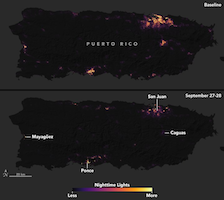
By Printus LeBlanc
Earlier this week, Secretary of Energy Rick Perry sent a proposed rule change to the Federal Energy Regulatory Commission regarding U.S. power grid reliability and resilience. When people discuss the electric grid they often interchange the terms reliability and resilience. What do these terms mean and how do they affect the lives of Americans? They may not realize it, but electric grid resilience and reliability ensure Americans can live the life they have today.
The U.S. power grid is part of the Energy Sector, which is one of Homeland Security’s sixteen critical infrastructure sectors. The grid is comprised of three smaller grids. One grid spans the East Coast to the Rocky Mountains while another serves people from the Rockies to the Pacific. The last grid is the state of Texas. Each of these individual grids is comprised of a network of power producing facilities, tens of thousands of miles of transmission lines, and hundreds of substations, bringing power to your home and business.
What is grid reliability? Grid reliability is the ability of a power grid to deliver electricity in sufficient quantities when needed. When someone turns a light switch on, the lights come on. The assembly line in Tennessee manufacturing trucks needs a reliable supply of electricity to run operations.
What is grid resilience? Grid resilience is the ability of a power grid to bounce back from a major incident. The incident can be a man-made incident, such as a terrorist attack, or a natural disaster such as a major hurricane. A resilient grid may suffer a disruption at the height of the event, but it will be back up quickly, sending electricity to customers.
Why is grid reliability important?
Growing children need good nutrition to grow up healthy and strong, and the same can be said for an economy. As the U.S. economy and population grow, an increased load is put on the power grid. U.S. energy consumption has grown so much, it has more than doubled since 1975. The increased load must be met with increased power generation.
A reliable grid allows an economy to grow. Commerce happens twenty-four hour a day, seven days a week. An unreliable supply of electricity slows down commerce thereby slowing down or even contracting the economy. An unreliable grid puts people out of work, reduces tax revenue, and increases dependency on government.
Why is grid resilience important?
Power grid resilience is important because your life literally depends on it. The southern states are only tolerable in the summer because of air conditioning. How horrendous would Atlanta, Ga. or Houston, Texas be in August if there was no way to cool them off? Houston regularly reaches a heat index of well over 100 degrees in the summer. Without electricity, deaths from heat exhaustion would skyrocket. Food that needs refrigeration will spoil in days, if not hours. Lifesaving medications that require refrigeration would spoil and become useless.
Public transportation is dependent on the power grid. All public metro trains move thanks to electricity. Public buses may run on diesel and compressed natural gas, but the pumps that fill those vehicles are electric. How would cities like New York and Washington D.C. be able to function without public transportation?
How would an economy work without electricity? It is a problem playing out before our very eyes in Puerto Rico. After an event, people need supplies. The supplies are bought with money. If there is no electricity, the physical cash is stuck in ATMs and bank vaults. Debit cards and credit cards will not work. Anarchy and violence will soon follow if people do not have the access to their money supply.
Trump Administration acts
Two of the more reliable forms of electricity generation are coal and nuclear. After eight years of the Obama administration using regulations to destroy the coal and nuclear power industries, the Trump administration has sought to turn that around with the new rule recommendation.
In a statement, Americans for Limited Government President Rick Manning praised the move, saying, ““In 2016, Coal and nuclear provided a combined 51 percent of electricity, in spite of Obama policies that are taking 374 coal power plants offline, and accelerating the decommissioning of 5 nuclear reactors. The rule announced by Department of Energy will help take the regulatory boot off the throats of these two vital pieces of our electric power grid puzzle.”
Perry has taken a bold step forward to ensure power grid reliability and resilience. Some will scoff, but in a natural disaster scenario that severely damages part of the grid, coal and nuclear will be the most reliable sources of power.
Coal power plants keep weeks worth of coal on site, and nuclear plants have power as long as they have nuclear fuel rods. Both types of plants can produce power in the most dire of situations. Natural gas plants cannot keep weeks worth of gas on site. Natural gas plants need pipelines to deliver the gas. Solar and wind only work when the sun is shining and the wind is blowing. It makes no sense put national security and the economy at risk by excluding the two most reliable sources of electricity generation. Yet, regulatorily that is the path we are on.
If this hurricane season has taught us anything, it is just how fragile the U.S. power grid is. From the NASA image, you can see what an unreliable un-resilient power grid looks like. The Trump administration is taking the threat seriously and has moved to diversify power generation capabilities. President Trump is to be commended for taking this first step and he must continue to undo the burdensome regulations intended to drive coal and nuclear out of business.
Printus LeBlanc is a contributing editor at Americans for Limited Government.